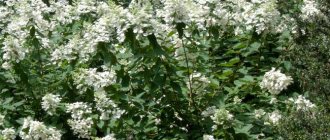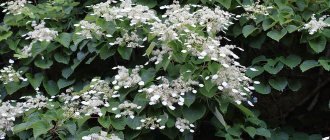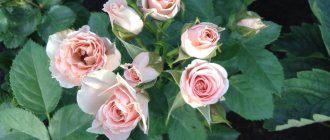In 1986, the Dutch breeder Peter Zwijnenburg released Paniculate Hydrangea Limelight onto the market. It received many awards, and still, 35 years later, remains one of the most sought-after varieties. The unique color of the inflorescences, high frost resistance, strong straight branches that do not require garter, even when overloaded with huge panicle caps, contribute to their popularity.
In Russia, the Limelight variety is sometimes sold under the name Lemon Light.
Botanical description
Hydrangea paniculata Limelight is a round, dense, deciduous shrub with straight, strong, reddish-brown shoots. They not only support the inflorescences well, but also do not bend under gusts of wind or during rainstorms.
The plant holds its shape perfectly and does not need garter or supports.
Foreign sources in the description of the Limelight variety indicate a height without pruning of up to 3 m. In the middle zone, the dimensions are more modest - even with good maintenance, the crown diameter barely reaches 2 m. The root system is powerful, but superficial, extending beyond the trunk circle.
Hydrangea leaves are large, about 10 cm long, with a velvety surface, clear veins and pointed tips. In autumn, the green color of the plates takes on a purple tint.
The annual growth of young Limelight hydrangea is up to 25 cm. An adult bush quickly recovers after short pruning, produces meter-long shoots over the season, and produces large inflorescences at their tips that bloom from early July to September or October.
Hydrangea Limelight forms dense, wide-conical panicles, mainly from four-petalled sterile corollas. Length depends on cutting:
- if this is not done, the Limelight inflorescences become smaller every year, eventually stopping at about 12 cm;
- with a short, 4 buds, panicles are formed about 20-25 cm;
- When growing conditions are good, in addition to annual pruning, shoots are additionally rationed and huge caps are formed, 30 cm long and 20 cm wide at the base.
Hydrangea Paniculata Limelight gained popularity due to the original coloring of the inflorescences. During the budding period and in the initial stages of opening the corollas, it is lime-colored, but in the bright sun it quickly turns into white. Aging flowers take on a pink or purple hue.
On especially large panicles an interesting effect is obtained. The tip of the hydrangea cone is lime, the middle is white, and the base is pinkish.
In partial shade, the greenish tint appears especially brightly and lasts longer.
In the fall, Limelight panicles can be cut off, dried indoors, and collected into a bouquet of dried flowers - they will last all winter and spring. The seeds do not ripen.
Trimming
In paniculate hydrangea Lemon lime, inflorescences form on the shoots of the current year. In the fall, all its buds are cut out. In the spring, before the buds awaken, old, broken branches are cut out, and 6-12 of the strongest are left. Old shoots are cut into a ring, and strong shoots are shortened by 3-4 pairs of buds. This procedure will promote more luxuriant flowering.
Trimming
If you cut out all the shoots and leave only one, you can form a hydrangea in the form of a tree - a trunk. Its branches develop only in the upper part. They will also need to be shortened periodically. If the plant is trimmed correctly, the result is a small tree with a lush crown.
Planting in open ground
Growing conditions affect the decorativeness and health of Limelight hydrangea, and an adult plant does not like to be moved. Therefore, the choice of location must be taken responsibly.
It is better to take seedlings from a nursery located to the north of the site. This way the plant goes from worse to better conditions, takes root faster, and enjoys better health throughout its life.
Deadlines
The time for planting Limelight hydrangea depends on the region:
- in the south this is done in the first half of autumn, when the heat subsides, but more than a month remains before frost;
- in the middle zone you can plant Limelight at the beginning or end of the season, at the discretion of the owners;
- for the North-West, Siberia, the Urals, the Far East, the only acceptable time is spring, when the soil warms up to 15 ° C or more, Limelight hydrangea should take root well before winter.
Although container hydrangeas can be planted regardless of the season, except for the hottest months, according to reviews, it is better to place the crop on the site within the specified time frame. This way adaptation happens faster.
Selection and preparation of a site
Limelight hydrangea is a short-day plant; it needs sun less than 12 hours a day, and intense lighting in the south is not necessary at all. There, hydrangea is planted in partial shade, where scorching rays cannot reach the bush.
In the middle zone, direct sun is acceptable in the morning or evening. At midday, Limelight hydrangea needs protection. Planting is done next to a fence, building wall, gazebos or other small architectural forms. You can place Limelight under the canopy of trees with an open crown, but with a deep root system, so that the plants do not compete for water or nutrients.
Garden crops in the northern regions already suffer from a lack of sunlight. In summer, the days there are long, but the radiation intensity is low and photosynthesis is sluggish. Hydrangea Limelight is planted in a well-lit place.
The site should be well-drained, with loose, nutritious, permeable, moist, slightly acidic soil. The culture grows on neutral soils, but the inflorescences there are smaller and not as beautiful as in magazine photos and in the description of the variety.
Soggy lowlands or elevated areas from which the wind quickly blows moisture away are not suitable for Limelight hydrangea.
Where the soil is already acidic and well-structured, it is recommended to additionally add coniferous litter from the nearest pine forest to the planting hole. It will enrich the root zone with mycorrhiza, which is very good for hydrangea. It is recommended to add a little clay to sandstones.
One of the planting mixture recipes if the soil needs to be changed completely:
- sour peat – 1 part;
- coniferous land – 1;
- sand – 0.5;
- matured humus – 0.5.
Landing algorithm
A hole for the hydrangea is dug 40 cm deep and 60 cm in diameter. In the closing areas, it is deeper so that there is room for drainage. Fill with planting mixture and spill with acidified water.
In autumn or spring, depending on the region, planting begins:
- Remove part of the substrate from the pit.
- Place a hydrangea seedling in the center so that the root collar is several centimeters below the edge.
- Cover with the substrate set aside and compress.
- A border strip is dug in around the perimeter of the tree trunk or an earthen roller is built.
- Water with a rooting solution. Each bush uses at least 2 buckets of water.
- Mulch with acidic peat and pine litter. This makes it easier to care for hydrangea - moisture is retained, weeds grow less, and there is no need to loosen the soil.
- The bush is shaded for several days.
You can often come across the statement that it is impossible to bury the root collar - it will dry out. Nothing like this. Hydrangea is a shrub, not a tree, and is also very moisture-loving. If the soil is loose and well permeable, the neck will not dry out, but once above the soil surface, it will certainly dry out in the summer or freeze in the winter.
Conditions for growing on a trunk
To grow hydrangea on a trunk, you need to take into account several parameters, which include lighting, temperature and humidity, and soil type.
Also find out how and when to replant a hydrangea to a new location.
Lighting
The shrub does not tolerate directly directed rays of the sun. It is best to plant the plant in areas where there is shade, and at midday the foliage does not suffer from sunlight.
Temperature and humidity
The plant is moisture-loving and does not tolerate dry soil. For this reason, lime hydrangea is planted in a place with moderate humidity. The optimal air temperature during the growing season is +22…+24°C. If it rises higher, it will be necessary to increase watering.
Pay attention to the information about why hydrangea blooms green.
The soil
Soils with a pH of 5 to 5.5 are considered ideal for planting and growing shrubs. On soils with a neutral pH (7.3), development will be slow, which may cause a lack of flowering. But you can always acidify the soil with peat.
Features of care
Contents Limelight differs little from other paniculate hydrangeas. It is important not to neglect the bush, to do everything on time.
Watering
Irrigation should be so frequent that the soil under the hydrangea does not dry out even for a short time. Pour under each bush:
- 2 buckets of water when short pruning is done in the spring, or Limelight hydrangea is grown on a trunk;
- if the plant is a multi-stemmed tall shrub - 20 liters for every 1 m of growth.
To preserve moisture, mulch the tree trunk circle.
At least once a month under Limelight hydrangea you need to acidify the soil. Use:
- fermented milk products – 2 liters per bucket;
- wine vinegar - 100 g for the same amount of liquid;
- citric acid - from 1 teaspoon to 2 tablespoons, depending on the pH level of the substrate and whether the owners perform the operation regularly or periodically.
It is recommended to settle hard or tap water before watering hydrangeas.
Feeding
Fertilize Limelight four times per season:
- in spring - nitrogen;
- twice - in the summer, with a full mineral complex with microelements, during the protrusion of buds and when the corollas bloom;
- in autumn - potassium and phosphorus without nitrogen.
In summer, it is recommended to use specialized fertilizers for hydrangeas and rhododendrons. There, all nutritional elements are given in a balanced form. You can give the crop fertilizer for conifers marked “summer”.
Before the buds open, it is recommended to alternately treat the crown with a solution of mineral fertilizers or chelates every 14 days. This will make the flowering more lush and the bush healthy - microelements are better absorbed through the leaves. After the corollas bloom, treatments are stopped so as not to reduce the decorative effect.
Trimming
In autumn, only the flower stalks are removed. In the spring, before sap flow begins, short pruning is done, leaving 3-4 internodes on strong shoots. Weak or thickening bushes are removed completely.
If you only carry out sanitary measures and cut off the ends of frozen branches, the hydrangea will be large, dotted with small inflorescences.
Hydrangea Limelight on a trunk is formed as follows:
- One strong shoot is left and tied to a peg, the rest are cut out at the root.
- When it grows to the desired height, the lateral shoots are removed. 3-5 strong branches are left on the top of the head, from which the crown is formed.
- The stem is kept clean by plucking out the awakened buds throughout the season.
Preparing for winter
The first 1-2 years after planting, with the onset of frost, young bushes are tied with spruce branches, or tilted to the ground, covered with leaves or pine needles, and non-woven material is secured on top.
When the Limelight hydrangea takes root, just mulch the tree trunk circle - cover it like a rosebush, but not with soil, but with acidic peat or pine litter. If the branches freeze, don’t worry – they will still need short pruning in the spring.
Reproduction
Hydrangea can be propagated in two ways - seeds and cuttings. The seed method is used very rarely, since it requires too much time and effort, but at the same time produces more seedlings. And cuttings are a quick and easy method, and the rooting process takes only a few months.
Did you know? Buddhists have a sacred holiday
—
birth of Buddha. On this grandiose day, it is customary to decorate the small hall of the temple with hydrangea flowers.
Seeds
With the onset of May, you can start sowing seeds. To do this you need to do the following:
- Prepare a container about 50 cm deep and up to 1 m wide.
- Fill in 2/3 of the soil mixture, which consists of garden soil, peat and coarse sand.
- The seeds are immersed in the soil 1–3 cm deep.
- Place a thin layer of sand on top.
- Afterwards, it is necessary to moisten the soil once every three days until completely absorbed.
- Place the container with seedlings under the trees.
- Every 30 days, feed with liquid professional fertilizers for hydrangeas.
- On cold days, containers must be brought into a warm room (but not higher than +18°C).
- After 2 years, the seedlings will be ripe for planting in open ground.
Prevention of diseases and pests
Limelight is a hydrangea variety with strong immunity. Most problems arise due to lack or errors of care; the best prevention is careful selection of the planting site and proper agricultural technology.
But pests and diseases still occur on Limelight:
- if an anthill grows next to hydrangeas, aphids colonize the young growths;
- in dry summers and with poor watering, spider mites appear on the leaves;
- walnut “shares” the sooty fungus with hydrangea;
- Powdery mildew is not uncommon during rainy, cold summers.
Owners do not often do preventive treatments for Limelight hydrangea. Problems are usually resolved as they arise.
Why does the plant dry out and the leaves turn yellow?
Often, the yellowing of the green mass of a shrub is affected by changes in the environment or improper care. In rare cases, the flower is deformed by pests.
The causes of yellowing of panicle hydrangea leaves are:
- deficiency or excess of moisture and light (the flower does not need to be over-watered or planted in an open sunny area, in the shade);
- powdery mildew (forms on the back side of the leaf blade in the form of a gray coating, yellowish-green spots form on the front side);
- lack of nutrients (to prevent the leaves from turning yellow, the plant must be fed regularly);
- low level of soil acidity (pH should be within 3-6 units, and the flower should not be cultivated in alkaline soil);
- draft (hydrangea does not like constant drafts and sudden changes in temperature).
The causes of wilting of a whole plant may be the following factors:
- deficiency of nutrients (at the stage of bud ripening and flowering, the crop needs to be fed once every 10 days);
- incorrect transplantation (the roots that absorb nutrients and water were deformed);
- lack of moisture (if the roots are overdried, the foliage will begin to dry);
- low level of humidity (if hydrangea is cultivated in greenhouses or enclosed spaces, it is necessary to ventilate and humidify the air near the bush).
Use in landscape design
Hydrangea Limelight in landscape design is suitable for creating gardens in a romantic or informal style, for zoning areas. It is planted in the foreground of tree groups, as a tapeworm, as undergrowth in a large area or as a hedge that does not require cutting.
The shrub looks good next to conifers or against the background of a lawn. Without annual pruning, it grows tall and can cover up a dilapidated building, a garbage heap or other unsightly corner.
Planting and caring for Limelight hydrangea is not particularly difficult. To get spectacular, large lime inflorescences, it is important to place the bush correctly, water it abundantly and often, prune it short in the spring, and feed it throughout the season.
Watering
Hydrangea is a plant that cannot do without moisture for a long time, and this fact is reflected in the Latin name of the plant. The soil in which the crop grows must always have a sufficient degree of moisture.
1
4
History of Hydrangea Limelight
Paniculate hydrangia (Hydrangea paniculata) was brought to Europe from Japan about two centuries ago. Almost immediately, breeders began working on the crop, developing new varieties. So, at the end of the 20th century, a Dutch company discovered the Limelight variety.
At the end of the 20th century, Dutch breeders developed the Limelight variety
The name was given to the shrub for its color, reminiscent of the color of a lime. Later, the hybrid received several prestigious awards and was recognized by the Royal Horticultural Society (Great Britain).
Rule 3. Feeding
In the first year, feeding is not required - fertilizers were added to the planting hole and they will be enough for the season. From the second year feeding is carried out, this is necessary to stimulate growth and bud formation. I recommend 3 feedings.
First
At the stage of blooming of the first leaf, in a temperate climate this is mid-May. The bush is shed with infusion of mullein or urea (2 tbsp/bucket of water).
Second
At the beginning of the appearance of buds, complex fertilizer is applied (in the Moscow region this is the end of June). Any fertilizer for flowering crops or nitroammofoska is used: 2 tbsp. l. under a bush, dig it in or use a solution (the same amount per 10 l).
Third
In September, food is given in the form of potassium-phosphorus fertilizers. Scatter 0.5 tbsp under the bush. superphosphate + 3 tbsp. l. potassium Fertilizers must be incorporated into the soil.
It is recommended to acidify the soil. Once every two years, the tree trunk circle is spilled with a solution of citric acid (1 tsp per 10 liters).
Gardeners' opinion
After reading the photos and reviews, purchasing Limelight hydrangea, you can be sure that it will decorate the garden with its lush blooms. The main thing is to organize proper watering and fertilizing for it.
This variety of hydrangea has been growing on my site for 5 years. No diseases or pests were observed. The only thing is that I couldn’t find specialized fertilizers, so during flowering I feed it with flower fertilizer for budding.
Julia, Tula
Excellent Limelight variety. I planted it and it is growing for the second year without problems, the only thing is that it requires watering almost constantly in hot weather. But I have water nearby and therefore receive water without restrictions.
Svetlana, Zlynka











